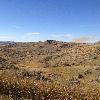Emily Pierson
RESEARCH OVERVIEW:

Drylands account for over 40 percent of the Earth’s landmass, have high ecological, economic, and social importance, but are highly susceptible to degradation. In North America, over 70 percent of drylands have been classified as moderate to severely degraded (Brauch & Spring, 2009), and there is an increasing recognition that restoration is crucial for healthy ecosystem functioning. Dryland systems are characterized by high annual climate variability causing restoration efforts to be successful in some years and not in others. The goal of current restoration practices is to reestablish native plant communities, generally from seed, which often results in low species diversity outcomes and invasion by non-native plants. Sagebrush steppe is of particular conservation interest throughout western North American, but establishment of big sagebrush (Artemisia tridentata) often fails, or recruitment is low, due to interactions with invasive species, such as cheatgrass, and precipitation variability. The objectives of my research are to facilitate sagebrush establishment and increase native species diversity in 1) newly restored dryland steppe, and 2) in areas where restoration has failed. We will achieve these objectives by evaluating the plant community response to a combination of management strategies including manipulation of seed mixes, sowing practices, and control strategies.
Brauch, H. G., & Spring, Ú. O. (2009). Securitizing the ground, grounding security: UNCCD.
Click on an image to view as a slideshow.





